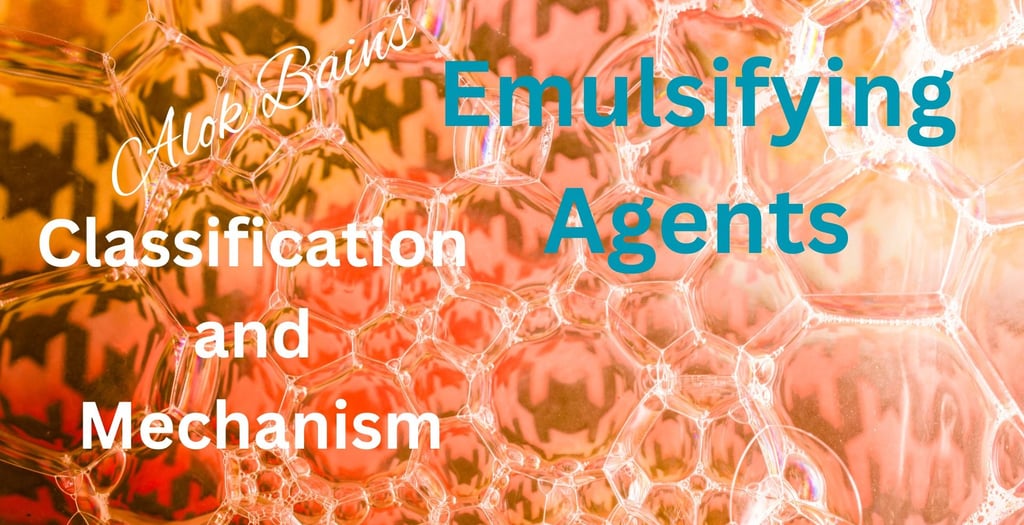Emulsifying Agents
Emulsifying Agents (Emulgent or Emulsifier)
PHARMACEUTICS
Alok Bains
12/3/20233 min read


Emulsifying agents (Emulgent or Emulsifier): Classification and Mechanism of Action
Emulsifying agents (Emulgent or Emulsifier):
Emulsifying agents act as surface active agent to reduce interfacial tension between two immiscible liquids to produce stable emulsion. Immiscible liquids are aqueous phase and oil phase. Mostly water polar (hydrophilic) emulsifying agents are used to make O/W emulsion. Non polar (lipophilic) emulsifying agents are used to make W/O emulsion.
Classification of emulsifying agents:
1. Emulsifying agents from natural sources
i. Emulsifying agents from plant sources: Acacia, Tragacanth, Agar, Pectin, Starch, etc
ii. Emulsifying agents from animal sources: Egg yolk, Wool fat, etc.
2. Semisynthetic emulsifying agents: Methyl cellulose, Sodium carboxy methyl cellulose.
3. Synthetic emulsifying agents: Anionic, cationic and non ionic.
4. Inorganic emulsifying agents: Magnesium oxide, Milk of magnesia, Magnesium trisilicate, Bentonite, etc
5. Saponins
6. Alcohol: Cholesterol, Lecithin, Carbowax, etc.
The following are details of individual emulsifying agent
1. Natural emulsifying agents from plant sources: Chemically they are carbohydrate and hydrophilic colloid. They are suitable for O/W emulsion due to their hydrophilic property. They increase viscosity of aqueous phase. Some of them are primary emulsifier (True emulsifier) and some act as secondary emulsifier (Emulsion stabilizer). Chemically they are carbohydrate thus they promote bacterial growth in emulsion. Thus preservative must be added in emulsion containing emulsifying agent from plant source. Some examples of preservatives are sodium benzoate, benzoic acid, alcohol, combination of methyl paraben and propyl paraben. Natural emulsifying agents are preferred for extemporaneous preparation.
2. Natural emulsifying agents from animal sources: Common examples are gelatine, egg yolk, and wool fat. Gelatin form white emulsion mainly used in liquid paraffin emulsion. It promotes growth of bacteria. Thus emulsion should have preservative. Egg yolk is itself emulsion and also acts as emulsifying agent due to presence of cholesterol and lecithin in egg yolk. It is rarely used due to its noxious smell. Wool fate is suitable for W/O emulsion meant for external application.
3. Semisynthetic emulsifying agents: Common examples are methyl cellulose and Sodium carboxymethyl cellulose. Methyl cellulose is synthetic derivatives of cellulose available as methyl cellulose 20, methyl cellulose 2500, methyl cellulose 4500, etc. Number indicates viscosity of 1% aqueous preparation in centipoises of methyl cellulose. They are suitable for O/W emulsion due to their hydrophilic property. They are used especially to prepare W/O emulsion of mineral oil and vegetable oil. They are stable in wide range of pH and addition of alcohol.
4. Synthetic emulsifying agents: They are further classified as anionic, cationic and non ionic emulsifying agents.
i. Anionic emulsifying agents: They bear negative charge. They are excellent emulsifying agents. They are used in emulsion meant for external application. Ex soap and fulphonated alcohol. Soap emulsion has high pH. They are not stable at pH less than 10. Soap emulsion becomes unstable on addition of acid and electrolytes.
ii. Cationic emulsifying agents: They bear positive charge. They are used to prepare emulsion for external application. They have also antibacterial activity. Thus they are used if germicidal activity is required. Example quaternary ammonium compounds such as benzalkonium chloride, cetrimide, etc. They are more effective in acidic pH.
iii. Non ionic emulsifying agents: They are widely used emulsifying agent. They remain stable in both acidic and alkaline pH. They remain stable even on addition of acid or electrolyte. Examples are glyceryl monostearate, polyoxyethyleneglycol ester, etc.
5. Inorganic emulsifying agents: They are mainly used in preparation of O/W emulsion. Examples are milk of magnesia, Magnesium oxide, magnesium trisilicate, bentonite, etc. Bentonite is used in both O/W emulsion and W/O emulsion. 5% suspension of bentonite is used as emulsifying agent.
6. Alcohol: High molecular weight alcoholic compound is used as emulsifying agent. Examples are cetyl alcohol, stearyl alcohol, cholesterol, etc. They are mainly used as secondary emulsifying agents. Carbowax is also alcohol. Its molecular weight varies from 200 to 1000. Its viscosity increases as molecular weight increases. Carbowax with molecular weight 200 to 700 are in liquid state. While cabowax with molecular weight 1000 is in solid state.
Hydrophilic Lipophilic Balance (HLB):
The HLB value is a numeric value that indicates affinity of emulsifying agents with oil and water. HLB value ranges from 0 to 40. But most of emulsifying agents HLB value ranges from 0 to 20. Emulsifying agents with low HLB value are suitable for W/O emulsion. They have high lipophilic property. Emulsifying agents with high HLB value are suitable for O/W emulsion. They have high hydrophilic property. Normally emulsifying agents with HLB value 3 to 6 are used for W/O emulsion. Emulsifying agent with HLB value 7 to 20 are used for O/W emulsion.
Mechanism of emulsifying agents: Emulsifying agents stabilize emulsion. They reduce inter-facial tension between two immiscible liquids such as oil and water. This forms stable interface between them. Emulsifying agents’ molecules have hydrophilic (Polar) and lipophilic (non-polar) ends. Lipophilic end of emulsifying agents attract oil phase and embedded into oil phase. Hydrophilic end of emulsifying agents attract water phase and embedded into water phase.This develops a layer around dispersed phase globules and blocks union of these globules. Each globules of dispersed phase dispersed individually into dispersion medium. This layer of emulsifying agent art interface between both liquids may be as mono molecular layer or multi molecular layer. Some emulsifying agents are solid particles. They concentrate around interface and develop a film around internal phase of emulsion.
Alok Bains
